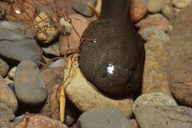|
Ascaphus truei Stejneger, 1899
Pacific Tailed Frog, Coastal Tailed Frog, Western Tailed Frog | family: Ascaphidae genus: Ascaphus |
| Species Description: Stejneger, L. 1899. Description of a new genus and species of discoglossoid toad from North America. Proceedings of the United States National Museum 21: 899.901. | |
 © 1999 Joyce Gross (1 of 99) |
|
|
|
Description Distribution and Habitat Country distribution from AmphibiaWeb's database: Canada, United States U.S. state distribution from AmphibiaWeb's database: California, Oregon, Washington Canadian province distribution from AmphibiaWeb's database: British Columbia
Life History, Abundance, Activity, and Special Behaviors Trends and Threats Possible reasons for amphibian decline Habitat modification from deforestation, or logging related activities Comments See another account at californiaherps.com.
References
Bull, E. L. and Carter, B. E. (1996). ''Tailed Frogs: Distribution, ecology, and association with timber harvest in Northeastern Oregon.'' United States Forest Service Research Paper, (497), 1-12. Ford, L.S., and Cannatella, D.C. (1993). "The major clades of frogs." Herpetological Monographs, 7, 94-117. [link] Nussbaum, R. A., Brodie, E. D., Jr., and Storm, R. M. (1983). Amphibians and Reptiles of the Pacific Northwest. University of Idaho Press, Moscow, Idaho. Orchard, S.A. (1992). ''Amphibian population declines in British Columbia.'' Declines in Canadian amphibian populations: designing a national monitoring strategy. C. A. Bishop nd K.E. Petit, eds., Canadian Wildlife Service, 10-13. Stebbins, R. C. (1985). A Field Guide to Western Reptiles and Amphibians. Houghton Mifflin, Boston. Stebbins, R.C. (1951). Amphibians of Western North America. University of California Press, Berkeley. Wallace, R. L. and Diller, L. V. (1998). ''Length of the larval cycle of Ascaphus truei in coastal streams of the redwood region, northern California.'' Journal of Herpetology, 32(3), 404-409. Originally submitted by: Alan Krakauer, Meredith J. Mahoney (first posted 1999-02-16) Distribution by: Michelle S. Koo (updated 2021-03-17)
Edited by: Duncan Parks and Meredith J. Mahoney (2021-03-17) Species Account Citation: AmphibiaWeb 2021 Ascaphus truei: Pacific Tailed Frog <https://amphibiaweb.org/species/2049> University of California, Berkeley, CA, USA. Accessed Nov 21, 2024.
Feedback or comments about this page.
Citation: AmphibiaWeb. 2024. <https://amphibiaweb.org> University of California, Berkeley, CA, USA. Accessed 21 Nov 2024. AmphibiaWeb's policy on data use. |




 Map of Life
Map of Life